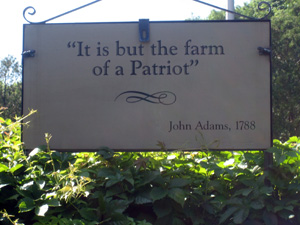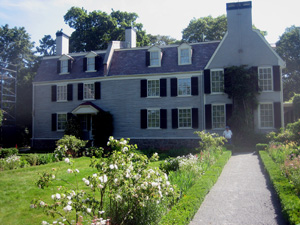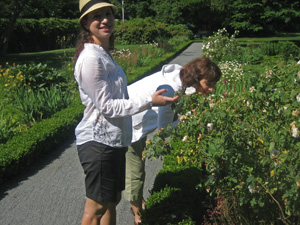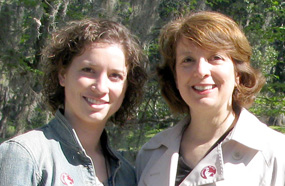

|
|
Empty Nest Magazine
|
TRAVEL
Quincy in a Day: Presidential History a “T” Stop from Boston by Emilie and Gretchen Haertsch
This mother-daughter team is traveling again! Recently, when Gretchen visited Emilie, now living in the Boston area, they made an excursion to the historic town of Quincy, MA, the home of presidents John Adams and his son John Quincy Adams. Quincy is only a 20-minute “T” ride south of Boston, and its historic sites can be enjoyed in the course of a day.
Museum of Quincy The first misperception dispelled by the museum was that the city took its name from John Quincy Adams. Rather, that honor belongs to Colonel John Quincy, maternal grandfather of Abigail Adams.

This sign hangs in front of Peacefield house, the Quincy, MA, home of John and Abigail Adams. John Adams was not wealthy by contemporary standards, and preferred a modest "farm."
After our visit to the Museum of Quincy, we decided to have an early lunch, as stopping would not be an option once we began to immerse ourselves in presidential history. The charming Gunther Tooties, a hybrid coffee and lunch shop and hot spot with the locals, was located conveniently nearby. We purchased some hearty sandwiches and tea and sat outside at the sidewalk tables to people watch while we ate. Once fortified, we were ready for all the presidential lore Quincy could throw at us.
United First Parish Church We were lucky enough to have a private tour guide who brought alive the rich history of the beautiful church, which still has an active Unitarian Universalist congregation. The highlight, however, was the mausoleum downstairs. There we found four tombs—those of John Adams, Abigail Adams, John Quincy Adams, and Louisa Catherine Adams. Standing next to the resting place of these figures of American history was quite a powerful experience, and our guide stood at a respectful distance while we lingered.
Adams National Historical Park

Peacefield house, as scene from the gardens.
Peacefield Today Peacefield remains a lovely Georgian-style house with black shutters, surrounded by extensive gardens. It is aptly named. Abigail Adams was quite a gardener, and her beds are still maintained. A rose bush that she planted herself blooms yet at Peacefield. You can be sure we paused to smell those roses! After the roses, our next stop on the property was the impressive Stone Library, which is a building separate from the residence. It was designed specifically to protect John Quincy Adams’s enviable collection of books: more than 14,000 volumes rising to the tall ceiling. The book lover in each of us swooned. From the library we entered the residence. As Peacefield was occupied by subsequent generations of Adamses before it became a historic site, it contains an extensive collection of family furniture, artifacts, and portraits. The tour is replete with anecdotal stories about Adams family life. For example, Louisa Catherine Adams, John Quincy Adams’s wife, was the only foreign-born first lady; she was English. And, like many new brides, she had mother-in-law problems. Abigail did not approve and tried to dissuade her son from marrying Louisa Catherine. Apparently, the problems of presidents and first ladies are not that different from our own.

Emilie and Gretchen smell the roses at Peacefield house, originally planted by Abigail Adams.
One of the most striking aspects of our visit to Peacefield was the real enthusiasm of the volunteers and Park Service employees for the Adams family. All of our guides spoke of the Adamses as if they not only knew them but liked them, as well. And they made us, the visitors, feel as though we knew them, too. When our guides opened the door to the dining room, we half expected to find John and Abigail sitting at the table. The trolley returned us to the visitor center, and our visit to Quincy was complete. This mother-daughter team left the city, having amply experienced the charm of the New England town, as well as discovering a great deal more about two American presidents and their wives and families.
If You Go
 Gretchen Haertsch lives in the Philadelphia area and teaches advanced writing courses at Arcadia University. Daughter Emilie Haertsch recently earned her MFA in Creative Nonfiction at Goucher College. She lives in near Boston and works as an assistant editor for content development at the Massachusetts Historical Society. The Haertsches last contributed to Empty Nest with a recap of their visit to Charleston, SC, in the Winter 2009–2010 issue. Gretchen Haertsch lives in the Philadelphia area and teaches advanced writing courses at Arcadia University. Daughter Emilie Haertsch recently earned her MFA in Creative Nonfiction at Goucher College. She lives in near Boston and works as an assistant editor for content development at the Massachusetts Historical Society. The Haertsches last contributed to Empty Nest with a recap of their visit to Charleston, SC, in the Winter 2009–2010 issue.
|
Empty Nest: A Magazine for Mature Families
© 2012 Spring Mount Communications